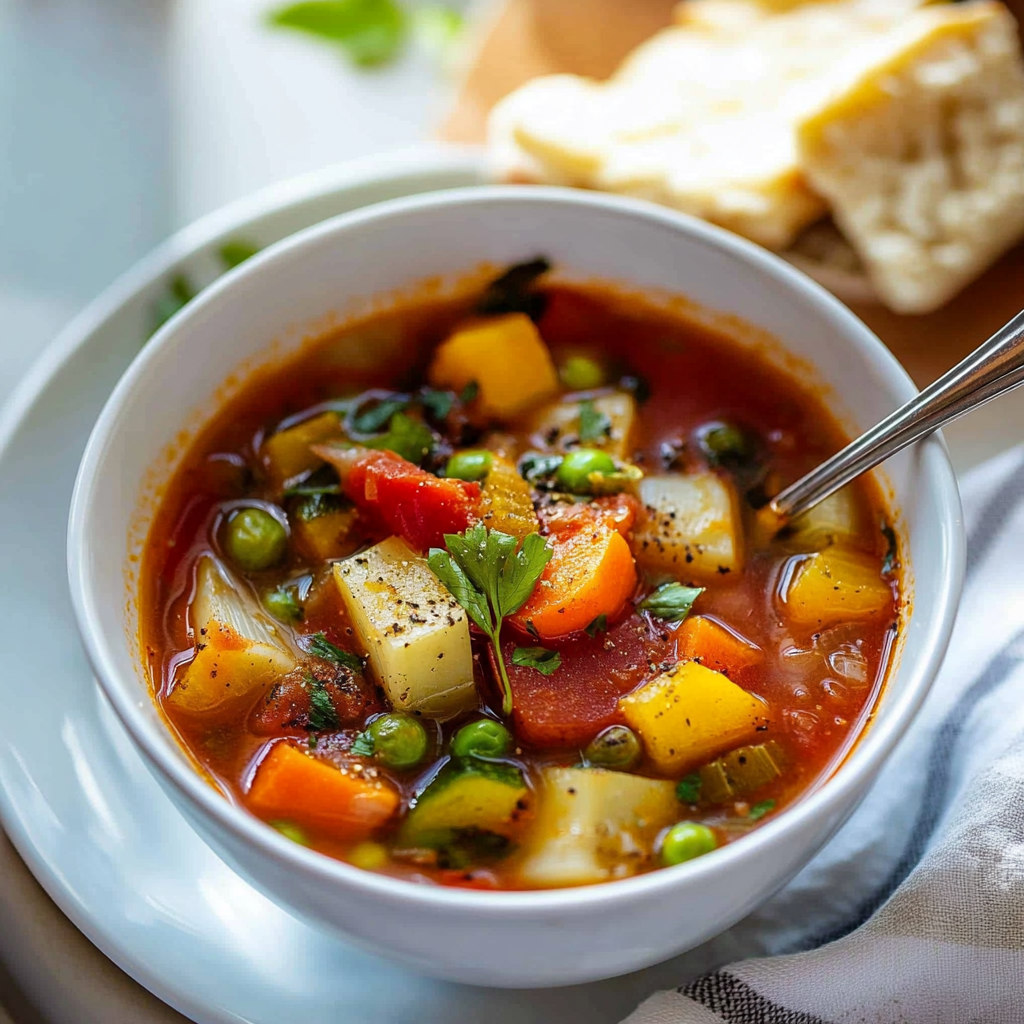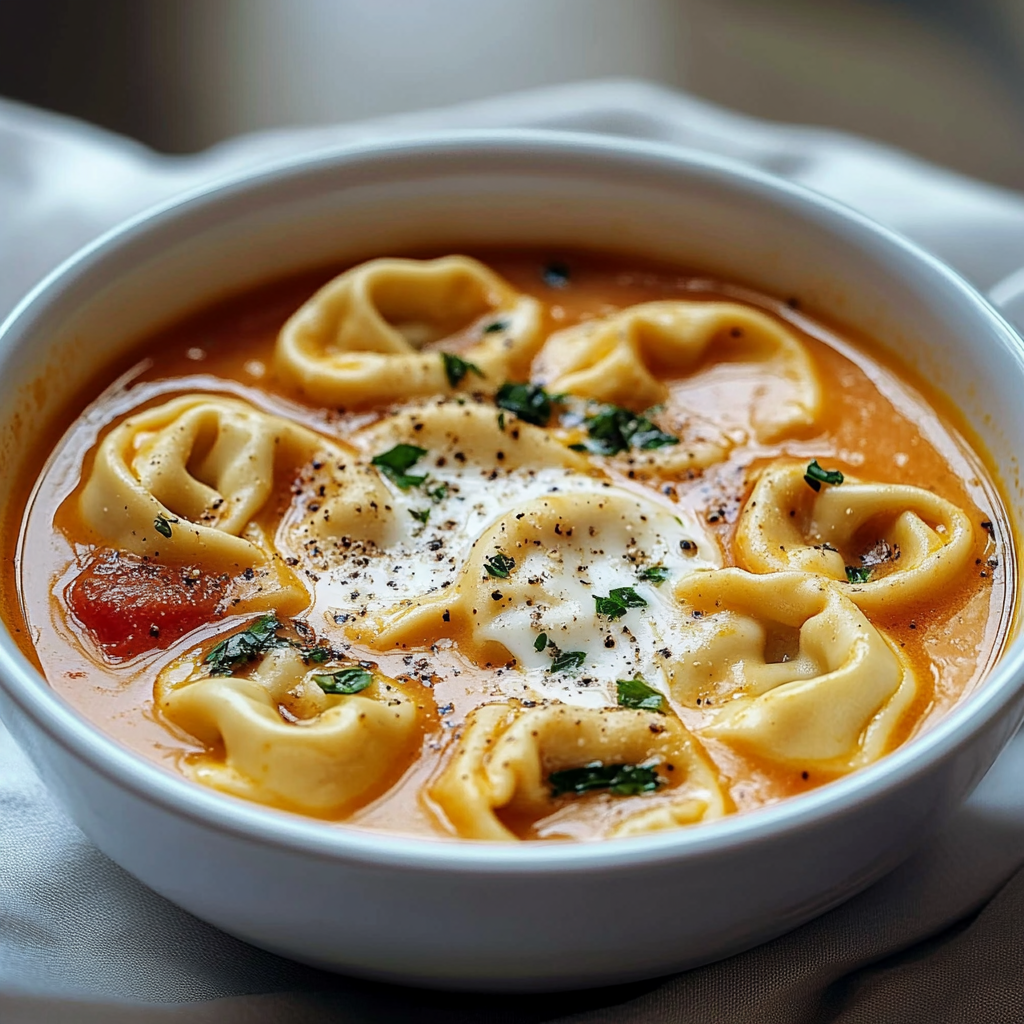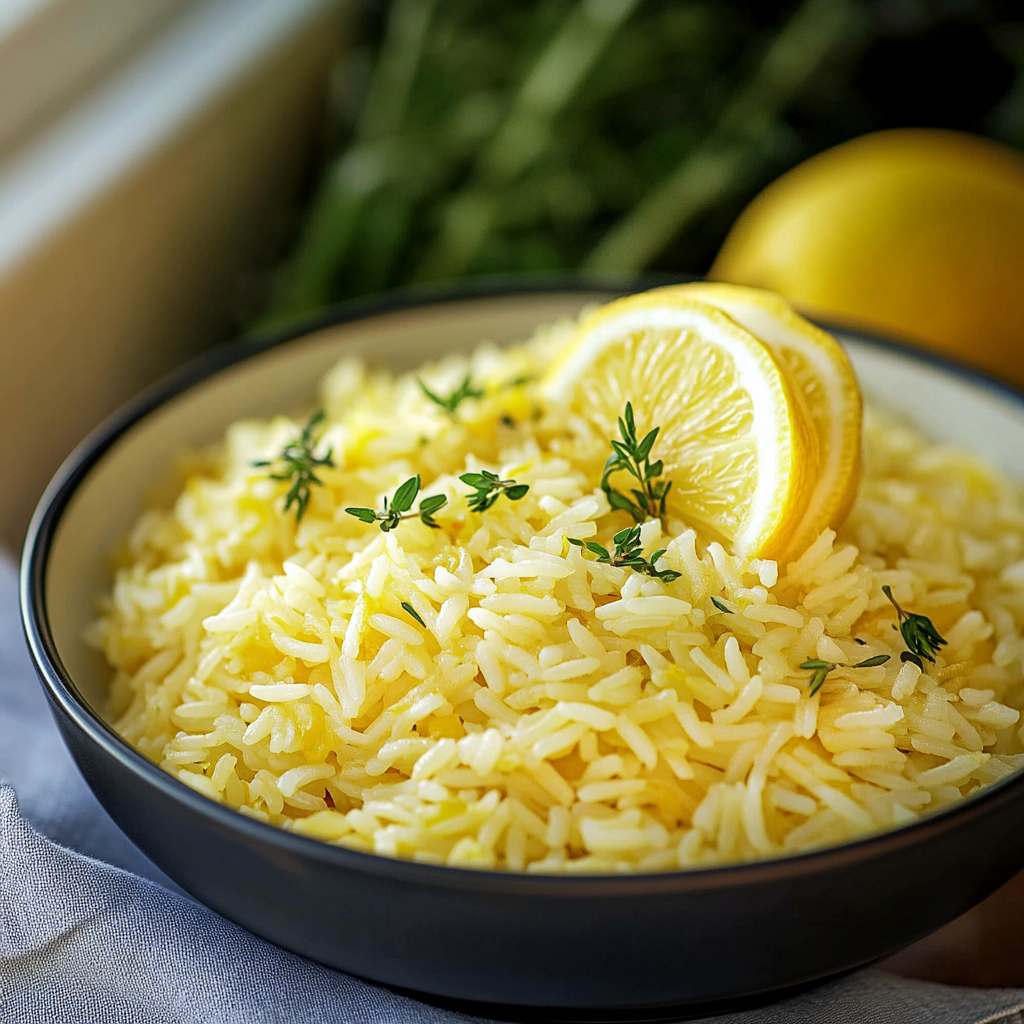Vegetable soup is the epitome of comfort food. It’s warm, hearty, and can be customized to suit your taste preferences. This nourishing dish is not only satisfying but also brimming with vitamins and minerals from fresh vegetables. In this article, you’ll learn how to prepare a delicious vegetable soup that you can enjoy any day of the week.
Whether you’re looking for a quick weeknight dinner or a cozy weekend meal, vegetable soup fits the bill perfectly. With its rich flavors and inviting aroma, it warms your heart and lifts your spirits. Plus, making vegetable soup at home is incredibly easy and economical. You can use whatever veggies you have on hand, minimizing waste while maximizing flavor.
Throughout this guide, we’ll go over the essential ingredients you’ll need to make your perfect pot of vegetable goodness. We will provide step-by-step instructions to ensure that even beginners can whip up this delightful dish without any hassle. Lastly, we’ll share helpful serving tips and storage ideas to keep your vegetable soup fresh for days. So roll up your sleeves and get ready to create a bowl of happiness!
Main Ingredients
Fresh Vegetables
Fresh vegetables are the star of your vegetable soup. Using a mix of colorful veggies not only enhances the visual appeal but also provides diverse nutrients. Common choices include carrots, celery, bell peppers, and zucchini. Aim for about 4 cups of chopped vegetables in total; feel free to mix according to what’s in season or what you have on hand.
Broth
The base of any good vegetable soup is broth. You can use store-bought or homemade vegetable broth; both options work wonderfully. For enhanced flavor, consider low-sodium broth to control salt levels in your dish. Approximately 6 cups will give you a nice balance without overwhelming the vegetables.
Herbs and Spices
Herbs such as thyme, parsley, or bay leaves are essential for elevating the flavor profile of your vegetable soup. Fresh herbs bring brightness while dried spices like black pepper or garlic powder add depth. Use about 1-2 teaspoons of dried herbs or 2-3 tablespoons of fresh herbs depending on your preference.
Olive Oil
A tablespoon of olive oil is perfect for sautéing your base vegetables like onions and garlic before adding in the rest of the ingredients. This helps release their natural flavors and creates a savory foundation for your soup.
Optional Add-ins
Consider adding proteins like beans or lentils for extra nutrition and substance if you desire a heartier meal. About 1 cup should suffice if you’re looking to enhance both texture and nutritional value without overpowering the primary flavors.
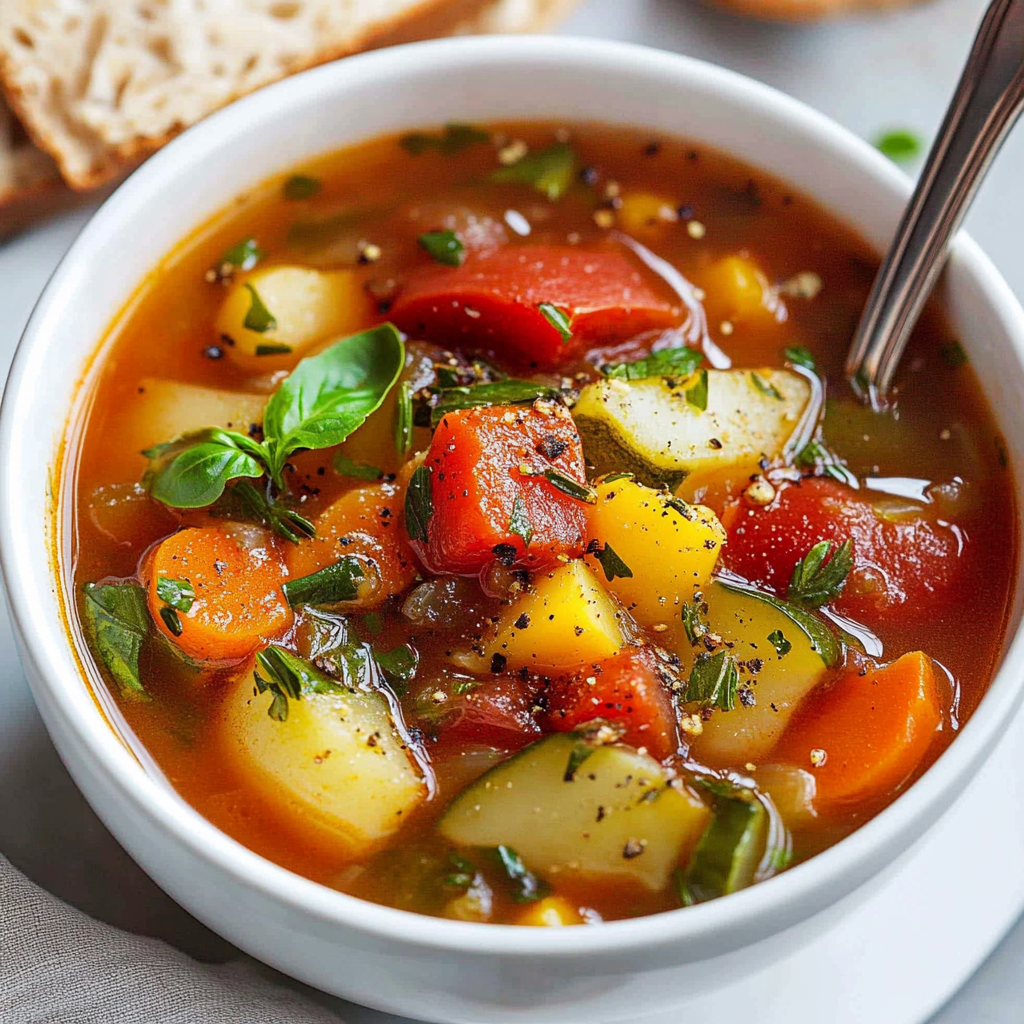
How to Prepare Vegetable Soup
Step 1: Sauté Aromatics
Start by heating one tablespoon of olive oil in a large pot over medium heat. Once hot, add finely chopped onions and minced garlic (about one clove). Stir occasionally until they become translucent—this usually takes about 3-5 minutes. This step builds flavor that serves as a foundation for your entire dish.
Step 2: Add Vegetables
Next up is incorporating your fresh vegetables into the pot. Begin with heartier options like carrots or celery since they take longer to soften compared to softer veggies like bell peppers or zucchini which you can add later on during cooking time. Stir everything together until well mixed—this allows all those aromatic flavors from the garlic and onions to infuse into every piece!
Step 3: Pour in Broth
Once all veggies are slightly softened (about 5 minutes), pour in approximately six cups of vegetable broth along with any optional seasonings you’d like such as salt or pepper at this stage too! Bring everything to a boil before reducing heat so it simmers gently—this allows flavors meld beautifully while ensuring nothing sticks at the bottom.
Step 4: Simmer & Cook
Now let it simmer! Covering partially will help retain heat yet still allow moisture escape preventing overcooking mushy textures rather than delightful bites! Aim for around 20-30 minutes until all ingredients reach desired tenderness; taste periodically adjusting seasoning where necessary throughout cooking process.
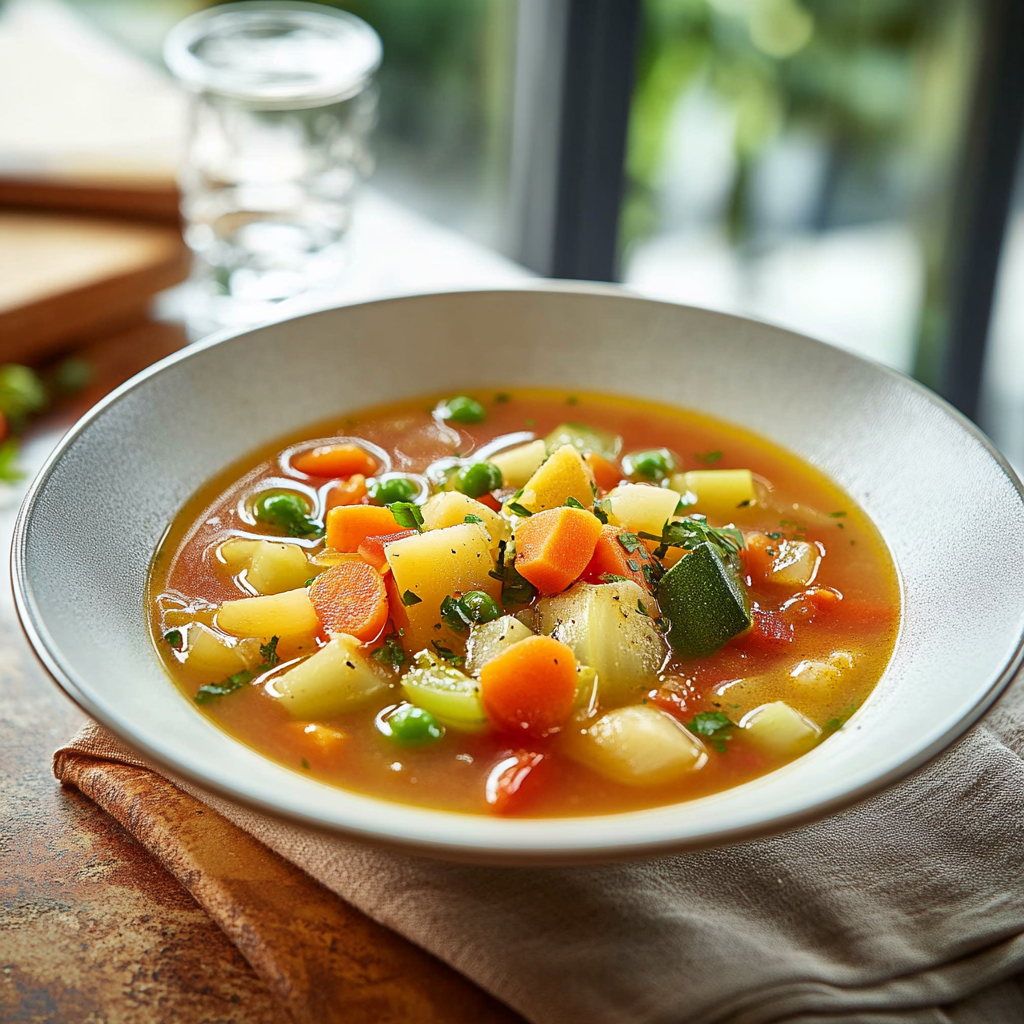
Serving and Storing Tips
Serving Suggestions
When serving your delicious vegetable soup, consider garnishing each bowl with freshly chopped herbs like parsley or basil for an added pop of color and freshness! You can also serve it alongside crusty bread or crackers which complement its comforting nature wonderfully—perfect for dipping into that savory goodness!
Storage Guidelines
To store leftover vegetable soup properly after enjoying delicious servings ensure it cools down completely before transferring into airtight containers—this will keep it fresh longer! Refrigerate within two hours post-cooking; soups typically last up to 5 days when refrigerated safely.
If you’d like extended shelf life? Consider freezing portions—just make sure they are cooled entirely first then stored in freezer-proof bags! They can stay good up-to three months when frozen allowing quick meals ready whenever cravings hit without compromising quality upon reheating either!
This comprehensive guide ensures you’ll create an unforgettable batch of wholesome veggie delight that nourishes both body & soul alike! Enjoy every spoonful knowing how incredible homemade truly tastes!
Mistakes to avoid:
Overcooking the Vegetables
One common mistake when making vegetable soup is overcooking the vegetables. When you cook vegetables for too long, they lose their vibrant color, texture, and vital nutrients. Instead of a fresh, flavorful soup, you may end up with a mushy mixture that lacks character. To avoid this mistake, add harder vegetables like carrots and potatoes first, allowing them to soften before adding softer items like spinach or zucchini. Keep an eye on cooking times and taste your soup regularly to ensure that each vegetable remains slightly crisp and retains its flavor. A well-cooked vegetable should be tender yet firm, providing a pleasing bite in every spoonful.
Using Low-Quality Ingredients
The quality of ingredients can significantly affect the taste of your vegetable soup. Using fresh, organic vegetables will enhance the overall flavor and nutritional profile of your dish. Avoid using wilted or old produce, as they can impart negative flavors into your soup. When selecting ingredients, look for seasonal vegetables that are in their prime; they tend to be more flavorful and cost-effective. Additionally, don’t forget about herbs and spices that can elevate your soup’s taste. Fresh herbs such as parsley or thyme can make a world of difference compared to dried alternatives. Always prioritize quality over quantity to achieve a delicious vegetable soup.
Ignoring Seasoning
Seasoning is crucial in transforming bland vegetable soup into a mouthwatering dish. Many home cooks often overlook the importance of seasoning throughout the cooking process. Instead of waiting until the end to add salt or spices, season your soup gradually as it simmers. This allows the flavors to meld together beautifully rather than just sitting on top of the ingredients. Remember that different vegetables have distinct flavor profiles; therefore, tailor your seasoning accordingly. Don’t hesitate to experiment with various herbs and spices—bay leaves, cumin, or even chili flakes can provide depth and warmth to your vegetable soup.
Skipping the Broth
A common pitfall in creating flavorful vegetable soup is skipping high-quality broth or stock. While water might seem like an easy option, it dilutes flavors significantly and results in a lackluster final product. Opt for homemade broth made from leftover vegetable scraps or invest in good store-bought options without additives if you’re short on time. The depth of flavor that a rich broth brings to your vegetable soup cannot be overstated; it serves as the foundation upon which all other flavors build. By starting with a robust base, you allow the natural tastes of your vegetables to shine through while enhancing their overall profile.
Tips and tricks:
Experiment with Different Vegetables
One of the best parts about making vegetable soup is the endless variety of vegetables you can use! Don’t feel restricted by traditional recipes; instead, let seasonal ingredients inspire you. Incorporate root vegetables like turnips or beets for added earthiness or leafy greens like kale for nutrition and texture variation. Try mixing different colors and shapes for visual appeal—your bowl will look more enticing! Each type of vegetable offers unique flavors and textures; experimenting helps you discover combinations that suit your palate perfectly while keeping meals exciting throughout the week.
Add Protein for Heartiness
To make your vegetable soup more filling and nutritious, consider adding protein sources such as beans, lentils, or even tofu if you’re looking for plant-based options. Including these elements not only boosts protein content but also enhances texture and flavor complexity in every spoonful. Beans are particularly great because they absorb surrounding flavors well; add them during cooking so they can soak up all that deliciousness! If you’re not vegetarian or vegan, shredded chicken or turkey works wonderfully too—just ensure it’s cooked beforehand so it blends seamlessly into the mix!
Use Acid to Brighten Flavors
Adding acidity can work wonders in elevating flavors within your vegetable soup! Ingredients like lemon juice or vinegar help balance out richer tastes while bringing brightness to each bite without overpowering other elements present in the dish itself. A splash added at the end of cooking provides freshness that cuts through heartier components such as potatoes or grains effectively! If you’re unsure how much acidity is needed initially—start small! You can always adjust afterward until achieving just-right levels tailored precisely according to personal preference.
Embrace Freezing Leftovers
Vegetable soup is perfect for batch cooking since it freezes exceptionally well! If you’ve made more than you can consume within a few days, freeze leftovers in individual portions using airtight containers or freezer bags—this makes reheating simple when hunger strikes later on! When stored correctly, frozen soups maintain their quality up to three months without losing flavor integrity! To reheat effectively from frozen state—remove appropriate portion size from freezer overnight (or microwave briefly) before warming gently over low heat until thoroughly heated through again—saving time while enjoying wholesome homemade goodness anytime desired!
Suggestions for vegetable soup:
Enhance Flavor with Herbs
Herbs play an essential role in enhancing flavor profiles within any recipe—including your favorite vegetable soup! Fresh herbs like basil, dill, cilantro contribute layers upon layers of aromatic goodness alongside earthy undertones found naturally among various types present within this dish itself! Consider adding them towards end stages during cooking process so they retain freshness without wilting away entirely under heat effects too much longer than necessary—often resulting flat-tasting results instead here!
Top with Crunchy Elements
For added texture contrast against smooth backdrop created by blended veggies within soups themselves—don’t shy away from including crunchy toppings such croutons roasted seeds nuts grated cheese etc., these little additions create delightful experiences transforming ordinary meals extraordinary ones instantly making each serving special somehow elevating entire experience beyond expectations altogether!
Pair Your Soup with Bread
Nothing complements a hearty bowl of vegetable soup quite like fresh bread! Whether it’s crusty artisan loaves baguettes soft dinner rolls garlic bread—you can’t go wrong pairing these elements together at mealtime both visually appealing delightful combination enjoyed endlessly throughout different seasons year round alike offering comforting warmth during colder months especially satisfying occasions shared friends family alike!
Add Creaminess if Desired
If you’re looking for ways to introduce creaminess into your vegetable soup without sacrificing health benefits entirely consider using alternative options such coconut milk cashew cream blended silken tofu instead traditional heavy creams usually found many recipes out there today achieving similar satisfying textures while keeping meals lighter easier digest ultimately making nutritious choices better overall enjoying guilt-free indulgence anyone deserves truly savor moments shared around table together enjoying delicious creations borne love passion culinary adventures embarked upon lovingly crafted dishes prepared thoughtfully care taken every step way possible ensuring satisfaction guaranteed every single time served hot steaming bowls joy served warm hearts alike always wanting return seconds thirds happily ever after!
FAQs:
What are the health benefits of vegetable soup?
Vegetable soup is a powerhouse of nutrients. Packed with vitamins, minerals, and antioxidants, it can enhance your immune system and promote overall health. The variety of vegetables used in the soup provides dietary fiber, which aids in digestion and helps maintain a healthy weight. Moreover, since vegetable soup is typically low in calories, it makes an excellent choice for those looking to manage their caloric intake without sacrificing flavor. Ingredients like carrots, spinach, and tomatoes deliver essential nutrients such as Vitamin A, Vitamin C, and potassium. Regular consumption of vegetable soup can also support heart health due to its low-fat content and high levels of heart-healthy ingredients. Overall, this comforting dish not only warms you up but also nourishes your body from the inside out.
How can I make vegetable soup more flavorful?
To elevate the flavor of your vegetable soup, start by sautéing onions or garlic in olive oil before adding other ingredients. This base layer of flavor sets the tone for the entire dish. Incorporating herbs like thyme, rosemary, or bay leaves can add depth and complexity. For a touch of heat, consider adding crushed red pepper flakes or a dash of hot sauce. Using homemade or low-sodium vegetable broth instead of water will enhance the overall taste significantly. Additionally, don’t shy away from experimenting with spices such as cumin or coriander to give your soup an exciting twist. Finally, finishing off with a splash of lemon juice or a sprinkle of fresh herbs right before serving can brighten the flavors and make your vegetable soup truly memorable.
Can I freeze vegetable soup?
Yes, you can freeze vegetable soup! Freezing is an excellent way to preserve leftovers or prepare meals in advance. To ensure that your soup maintains its quality when frozen, let it cool completely before transferring it to airtight containers or freezer bags. Leave some space at the top of the container because liquids expand when frozen. Most vegetable soups freeze well for up to three months; however, some vegetables may lose their texture after thawing. To reheat frozen vegetable soup, simply place it in the refrigerator overnight to defrost and then heat on the stove over medium heat until warmed through. This makes it convenient for busy days when you need a quick meal without compromising on nutrition.
What vegetables are best for making vegetable soup?
When preparing vegetable soup, consider using a mix of seasonal vegetables for optimal flavor and nutrition. Classic choices include carrots, celery, onions, potatoes, bell peppers, and tomatoes. Leafy greens like spinach or kale add vibrant color and extra nutrients. Root vegetables such as parsnips or turnips provide a hearty texture while zucchini adds freshness to the mix. Feel free to incorporate any leftover vegetables you have in your fridge to reduce waste and create unique flavors! Remember that each type brings its own taste profile; therefore mixing different vegetables will give your soup depth and dimension that is both satisfying and nutritious.
How long does homemade vegetable soup last in the fridge?
Homemade vegetable soup can last in the refrigerator for about three to four days if stored properly in an airtight container. To maximize freshness and prevent spoilage, make sure that your refrigerator is set at 40°F (4°C) or lower. Always allow your soup to cool before placing it in the fridge; this helps prevent condensation buildup inside the container that could lead to bacteria growth. If you think you won’t consume it within this time-frame, consider freezing portions for later use instead. Just remember that certain vegetables may alter their texture upon reheating after freezing but will still be safe to eat.
Is vegetable soup suitable for vegans?
Absolutely! Vegetable soup is inherently vegan-friendly since it primarily consists of plant-based ingredients such as vegetables, legumes, grains, herbs, and spices. You can customize it easily by avoiding animal products like meat or dairy while enhancing flavors with ingredients like nutritional yeast for a cheesy taste or coconut milk for creaminess without compromising on ethics or nutrition. Many classic recipes align perfectly with vegan diets by focusing solely on whole food ingredients that promote health while being deliciously satisfying.
Print
Easy Vegetable Soup Recipe for a Healthy Meal
- Total Time: 45 minutes
- Yield: Serves 6
Description
Vegetable soup is a comforting and nourishing dish, perfect for any season. Bursting with vibrant colors and fresh flavors, this easy homemade veggie soup is not only healthy but also incredibly versatile. Customize it with your favorite seasonal vegetables and herbs to create a delightful meal that warms the soul. Ideal for busy weeknights or cozy weekends, this recipe is a must-try for anyone looking to enjoy a wholesome bowl of goodness.
Ingredients
– 4 cups assorted fresh vegetables (e.g., carrots, celery, bell peppers, zucchini)
– 6 cups vegetable broth (low-sodium recommended)
– 1 tablespoon olive oil
– 1-2 teaspoons dried herbs (e.g., thyme, parsley)
– Salt and pepper to taste
– Optional: 1 cup beans or lentils for added protein
Instructions
1. Heat olive oil in a large pot over medium heat. Sauté chopped onions and minced garlic until translucent (3-5 minutes).
2. Add harder vegetables like carrots and celery; stir for another 5 minutes.
3. Pour in vegetable broth and any optional seasonings; bring to a boil.
4. Reduce heat and let simmer partially covered for 20-30 minutes until all vegetables are tender.
Notes
Feel free to get creative with your vegetable choices or add proteins like beans for heartiness. Consider a splash of lemon juice at the end to brighten the flavor!
- Prep Time: 15 minutes
- Cook Time: 30 minutes
Nutrition
- Calories: 150
- Fat: 3g
- Carbohydrates: 30g
- Fiber: 7g
- Protein: 5g
In summary, vegetable soup offers numerous health benefits while providing comfort and warmth during any season. It serves as an excellent source of essential nutrients thanks to its diverse range of vegetables packed with vitamins and minerals vital for maintaining good health. Enhancing flavors through various techniques allows you to create a unique dish tailored to your taste preferences while keeping things simple yet delicious. The versatility of this recipe means you can easily adapt it based on available ingredients or dietary needs—whether vegan-friendly or packed with protein-rich legumes! By knowing how long your homemade creation lasts in storage options like refrigeration or freezing methods ensures no waste occurs while enjoying wholesome meals throughout the week! So grab your favorite veggies today and get started on making a delicious pot of nourishing vegetable soup!

